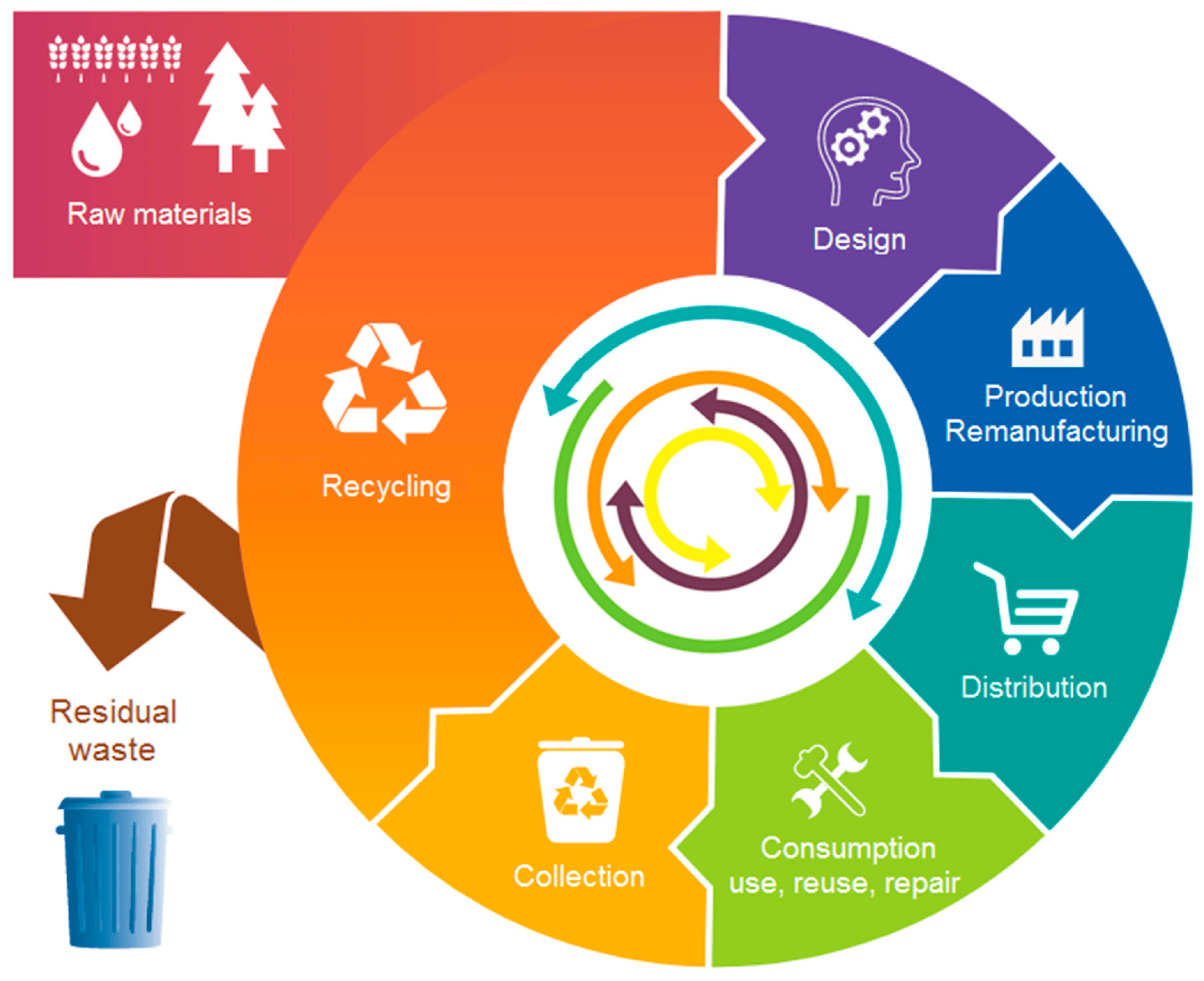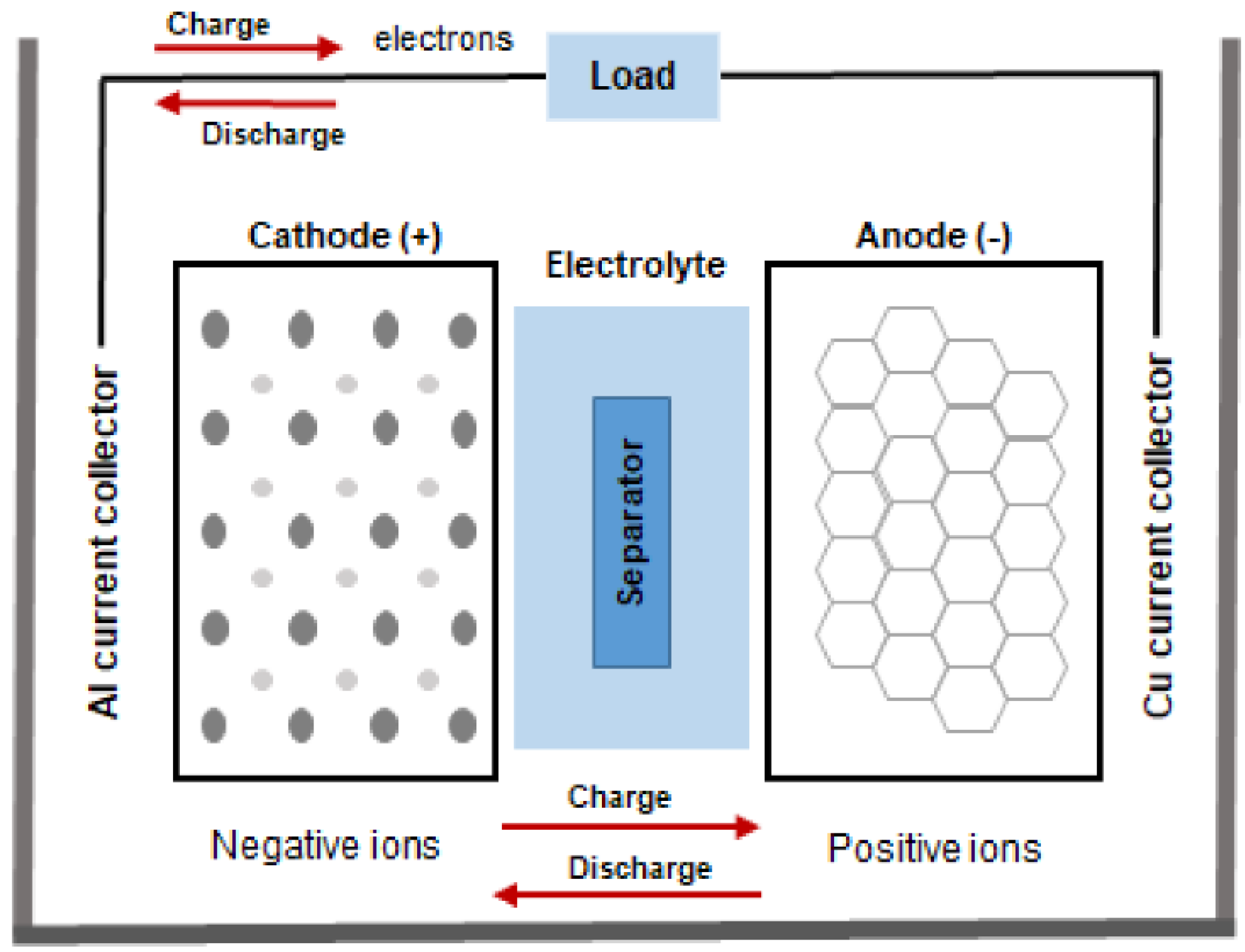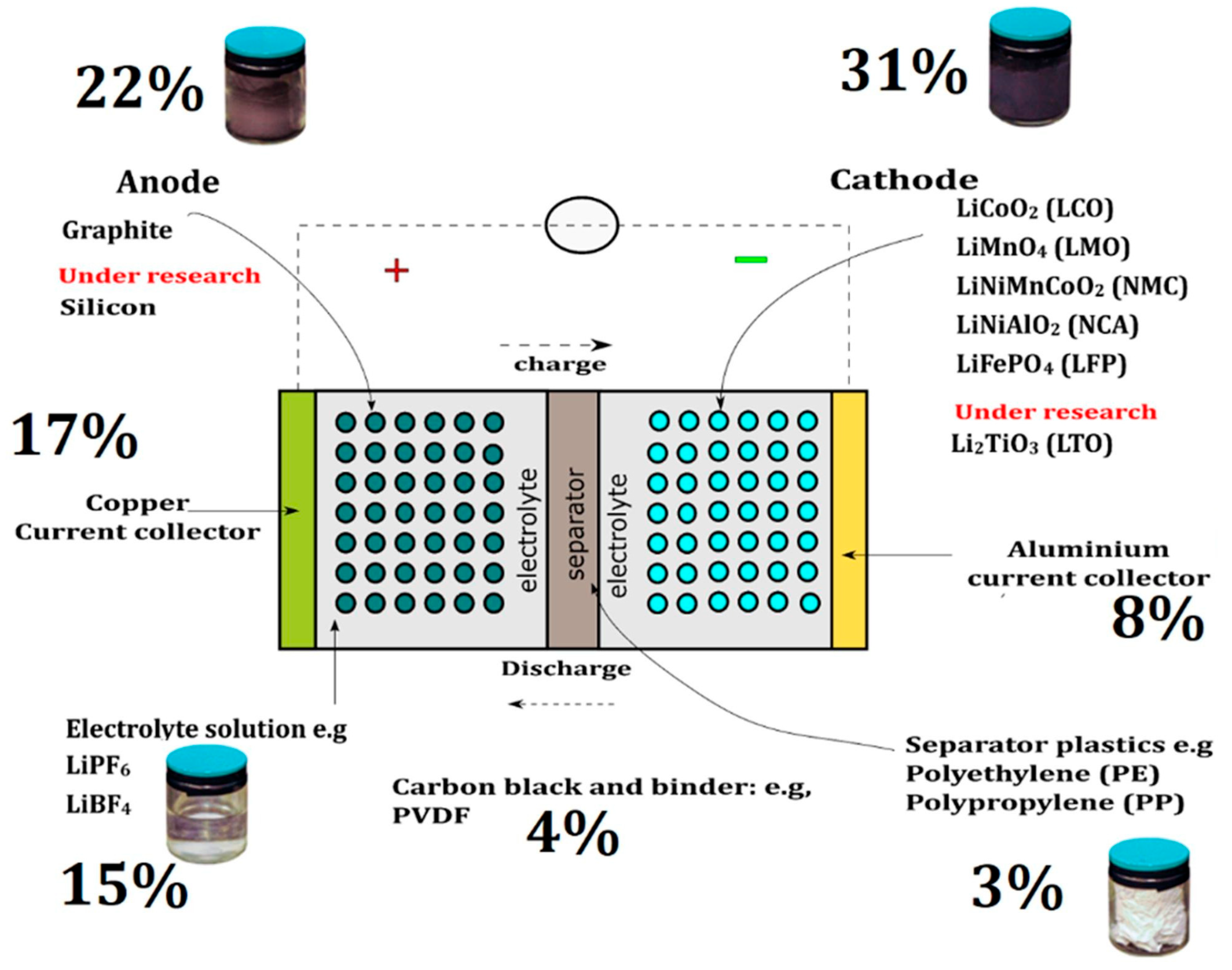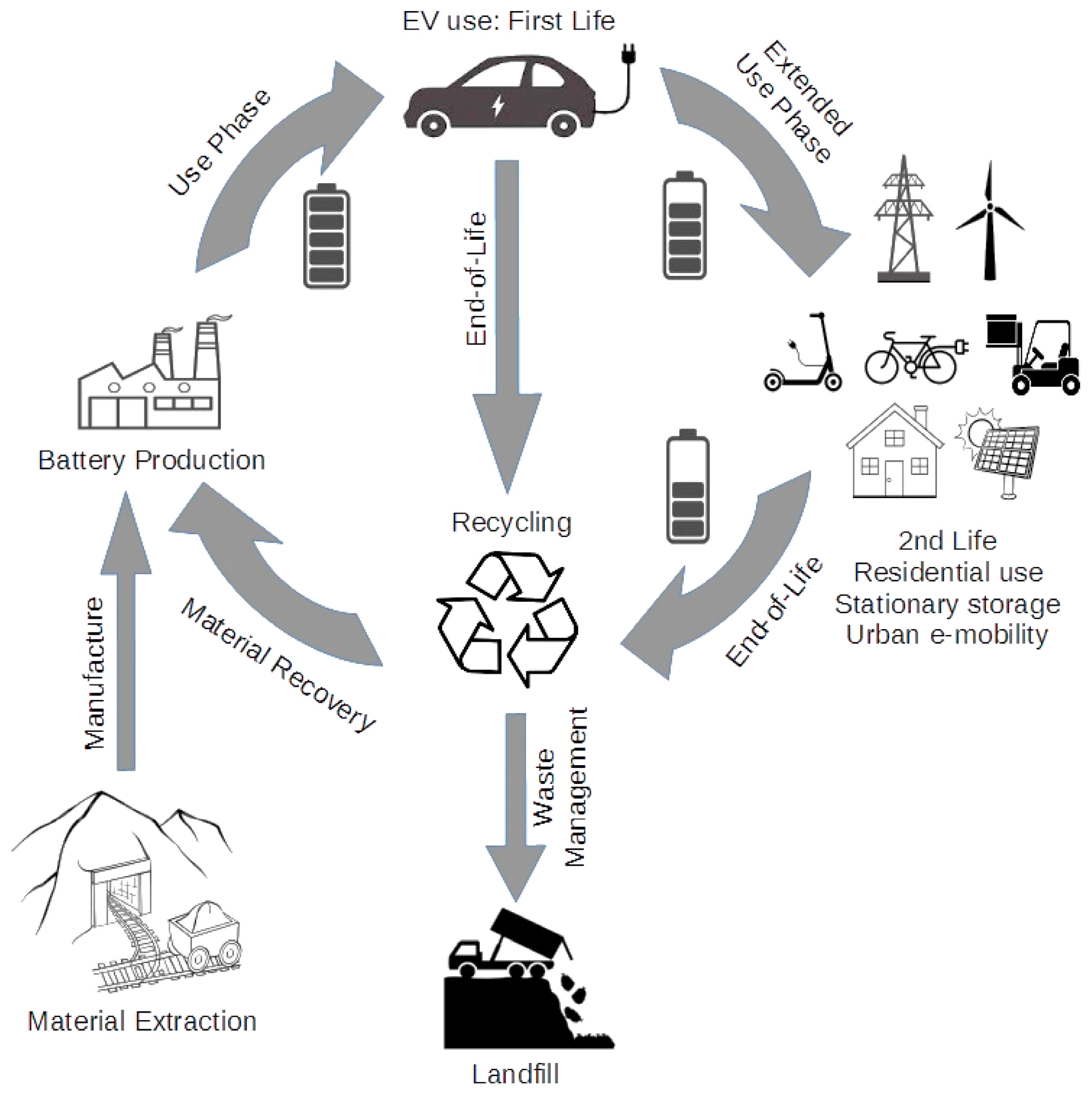Pathways to Circular Economy for Electric Vehicle Batteries
Abstract
:1. Introduction
1.1. Overview of Electric Vehicles and Battery Technology
1.1.1. Growth of the Electric Vehicle Market
1.1.2. Importance of Batteries in Electric Vehicles
1.2. End-of-Life Challenges for Electric Vehicle Batteries
1.2.1. Environmental Impact of Disposal
1.2.2. Resource Recovery Opportunities
1.3. Circular Economy Principles and Their Application
1.3.1. Circular Economy in the Context of EV Batteries
1.3.2. Objectives and Scope of the Review
2. Lifecycle of Electric Vehicle Batteries
2.1. Battery Composition and Materials
2.1.1. Overview of Battery Components
2.1.2. Identification of Critical Materials
2.2. Manufacturing and Use Phase
2.2.1. Environmental Impact during Production
2.2.2. Considerations during the Operational Life of EV Batteries
2.3. End-of-Life Phase
2.3.1. Challenges in Battery Disposal
2.3.2. Opportunities for Circular Practices
3. Circular Economy Strategies for End-of-Life EV Batteries
3.1. Battery Recycling Technologies
3.1.1. Overview of Existing Recycling Methods
3.1.2. Innovations in Battery Recycling Technologies
3.2. Second-Life Applications
3.2.1. Reuse of EV Batteries for Stationary Energy Storage
3.2.2. Repurposing Batteries for Nonvehicular Applications
3.3. Material Recovery and Resource Conservation
3.3.1. Recovery of Valuable Materials from Spent Batteries
3.3.2. Strategies for Minimizing Waste and Environmental Impact
4. Environmental and Social Impacts
4.1. Environmental Benefits of Circular EV Batteries
4.1.1. Reduction in Environmental Pollution and Resource Depletion
4.1.2. Contribution to a Sustainable Materials Lifecycle
4.2. Social Considerations and Stakeholder Engagement
4.2.1. Community Involvement in Circular Battery Initiatives
4.2.2. Social Acceptance and Ethical Considerations in End-of-Life Practices
5. Challenges and Barriers
5.1. Technological Challenges
5.1.1. Limitations in Current Recycling Technologies
5.1.2. Technical Obstacles in Repurposing and Second-Life Applications
5.2. Regulatory and Policy Challenges
5.2.1. Evaluation of Existing Regulations and Policies
5.2.2. Recommendations for Policy Improvements to Support Circular Practices
6. Future Directions and Research Needs
6.1. Research Gaps and Opportunities
6.1.1. Areas Requiring Further Investigation and Development
6.1.2. Potential for Interdisciplinary Collaboration and Knowledge Transfer
6.2. Roadmap for Future Circular EV Battery Initiatives
6.2.1. Key Steps toward Widespread Adoption of Circular Practices
6.2.2. Collaborative Efforts and Partnerships for Industry Transformation
6.3. Trends towards a Circular Economy
6.3.1. Future Scientific Breakthroughs in EV Battery Recycling
6.3.2. Increased Interest in EV Battery Research
7. Conclusions
Funding
Conflicts of Interest
References
- Herrmann, F.; Rothfuss, F. Introduction to Hybrid Electric Vehicles, Battery Electric Vehicles, and off-Road Electric Vehicles. In Advances in Battery Technologies for Electric Vehicles; Elsevier: Amsterdam, The Netherlands, 2015; pp. 3–16. [Google Scholar]
- Electric Vehicles. Available online: https://www.iea.org/energy-system/transport/electric-vehicles (accessed on 30 August 2024).
- Trends in the Electric Vehicle Industry—Global EV Outlook 2024—Analysis. Available online: https://www.iea.org/reports/global-ev-outlook-2024/trends-in-the-electric-vehicle-industry (accessed on 6 August 2024).
- Electric Vehicles—Worldwide|Statista Market Forecast. Available online: https://www.statista.com/outlook/mmo/electric-vehicles/worldwide (accessed on 10 August 2024).
- What Are the Consumer and Societal Reactions towards Electric Vehicles? Available online: https://www.greenbook.org/insights/what-are-consumer-reactions-to-electric-vehicles (accessed on 6 August 2024).
- Ibrahim, A.; Jiang, F. The Electric Vehicle Energy Management: An Overview of the Energy System and Related Modeling and Simulation. Renew. Sustain. Energy Rev. 2021, 144, 111049. [Google Scholar] [CrossRef]
- Zhang, X.; Liang, Y.; Yu, E.; Rao, R.; Xie, J. Review of Electric Vehicle Policies in China: Content Summary and Effect Analysis. Renew. Sustain. Energy Rev. 2017, 70, 698–714. [Google Scholar] [CrossRef]
- Mohammadzadeh, N.; Zegordi, S.H.; Kashan, A.H.; Nikbakhsh, E. Optimal Government Policy-Making for the Electric Vehicle Adoption Using the Total Cost of Ownership under the Budget Constraint. Sustain. Prod. Consum. 2022, 33, 477–507. [Google Scholar] [CrossRef]
- Ralls, A.M.; Leong, K.; Clayton, J.; Fuelling, P.; Mercer, C.; Navarro, V.; Menezes, P.L. The Role of Lithium-Ion Batteries in the Growing Trend of Electric Vehicles. Materials 2023, 16, 6063. [Google Scholar] [CrossRef]
- Das, U.K.; Shrivastava, P.; Tey, K.S.; Idris, M.Y.I.B.; Mekhilef, S.; Jamei, E.; Seyedmahmoudian, M.; Stojcevski, A. Advancement of Lithium-Ion Battery Cells Voltage Equalization Techniques: A Review. Renew. Sustain. Energy Rev. 2020, 134, 110227. [Google Scholar] [CrossRef]
- How Do Electric Cars Work? An In-Depth Guide. Available online: https://www.edmunds.com/electric-car/articles/how-do-electric-cars-work.html (accessed on 6 August 2024).
- Batteries Are a Key Part of the Energy Transition. Here’s Why. Available online: https://www.weforum.org/agenda/2021/09/batteries-lithium-ion-energy-storage-circular-economy/ (accessed on 6 August 2024).
- Morse, I. A Dead Battery Dilemma. Available online: https://www.sciencemagazinedigital.org/sciencemagazine/21_may_2021/MobilePagedArticle.action?articleId=1692939 (accessed on 6 August 2024).
- Woollacott, E. Electric Cars: What Will Happen to All the Dead Batteries? BBC News, 27 April 2021. [Google Scholar]
- Inc, C. Cyient|Blogs|Shyam Sundar Pal. Available online: https://www.cyient.com/blog/author/shyam-sundar-pal (accessed on 6 August 2024).
- EV Manufacturers Looking to Decarbonize—And Profit from It|HERE. Available online: https://www.here.com/learn/blog/ev-battery-sustainability-recycling (accessed on 6 August 2024).
- What Is the Circular Economy, and Why Does It Matter That It’s Shrinking? Available online: https://www.weforum.org/agenda/2022/06/what-is-the-circular-economy/ (accessed on 6 August 2024).
- Pereira, P.M.; Vieira, C.S. A Literature Review on the Use of Recycled Construction and Demolition Materials in Unbound Pavement Applications. Sustainability 2022, 14, 13918. [Google Scholar] [CrossRef]
- Bhutada, G. The Key Minerals in an EV Battery. Available online: https://elements.visualcapitalist.com/the-key-minerals-in-an-ev-battery/ (accessed on 10 August 2024).
- Policy Challenges for Accessing Critical Minerals to Electrify Vehicle Transport. Available online: https://www.rff.org/publications/reports/policy-challenges-for-accessing-critical-minerals-for-electric-vehicles/ (accessed on 10 August 2024).
- Battery Recycling: 10 Breakthrough Technologies. 2023. Available online: https://www.technologyreview.com/2023/01/09/1064886/battery-recycling-10-breakthrough-technologies-2023/ (accessed on 6 August 2024).
- Alternative Fuels Data Center: Batteries for Electric Vehicles. Available online: https://afdc.energy.gov/vehicles/electric-batteries (accessed on 6 August 2024).
- Zhang, R.; Fujimori, S. The Role of Transport Electrification in Global Climate Change Mitigation Scenarios. Environ. Res. Lett. 2020, 15, 034019. [Google Scholar] [CrossRef]
- Zubi, G.; Dufo-López, R.; Carvalho, M.; Pasaoglu, G. The Lithium-Ion Battery: State of the Art and Future Perspectives. Renew. Sustain. Energy Rev. 2018, 89, 292–308. [Google Scholar] [CrossRef]
- How Lithium-Ion Batteries Work. Available online: https://www.energy.gov/energysaver/articles/how-lithium-ion-batteries-work (accessed on 6 August 2024).
- Thi, M.T.; Kim, C.; Kwon, S.; Kang, H.; Ko, J.M.; Kim, J.; Choi, W. Investigation of the Properties of Anode Electrodes for Lithium–Ion Batteries Manufactured Using Cu, and Si-Coated Carbon Nanowall Materials. Energies 2023, 16, 1935. [Google Scholar] [CrossRef]
- Beaudet, A.; Larouche, F.; Amouzegar, K.; Bouchard, P.; Zaghib, K. Key Challenges and Opportunities for Recycling Electric Vehicle Battery Materials. Sustainability 2020, 12, 5837. [Google Scholar] [CrossRef]
- Larouche, F.; Tedjar, F.; Amouzegar, K.; Houlachi, G.; Bouchard, P.; Demopoulos, G.P.; Zaghib, K. Progress and Status of Hydrometallurgical and Direct Recycling of Li-Ion Batteries and Beyond. Materials 2020, 13, 801. [Google Scholar] [CrossRef] [PubMed]
- Deng, J.; Bae, C.; Denlinger, A.; Miller, T. Electric Vehicles Batteries: Requirements and Challenges. Joule 2020, 4, 511–515. [Google Scholar] [CrossRef]
- Yu, D.; Huang, Z.; Makuza, B.; Guo, X.; Tian, Q. Pretreatment Options for the Recycling of Spent Lithium-Ion Batteries: A Comprehensive Review. Miner. Eng. 2021, 173, 107218. [Google Scholar] [CrossRef]
- Liu, Y.; Zhang, R.; Wang, J.; Wang, Y. Current and Future Lithium-Ion Battery Manufacturing. iScience 2021, 24, 102332. [Google Scholar] [CrossRef]
- Konda, K.; Moodakare, S.B.; Kumar, P.L.; Battabyal, M.; Seth, J.R.; Juvekar, V.A.; Gopalan, R. Comprehensive Effort on Electrode Slurry Preparation for Better Electrochemical Performance of LiFePO4 Battery. J. Power Sources 2020, 480, 228837. [Google Scholar] [CrossRef]
- Jiao, X.; Kirianova, A.V.; Xu, X.; Kapitanova, O.O.; Krivchenko, V.A.; Napolskiy, F.S.; Volkov, V.S.; Gallyamov, M.O.; Liu, Y. Conductive Additives for Improving the Rate Capability of Cathode Materials in Secondary Lithium Batteries. ACS Appl. Energy Mater. 2023, 6, 2855–2862. [Google Scholar] [CrossRef]
- Lithium-Ion Batteries and Fluoromaterials|Fluorochemicals|Daikin Global. Available online: https://www.daikinchemicals.com/magazine/column-lithium-ion-battery-vol1.html (accessed on 6 August 2024).
- Luchkin, S.Y.; Kirsanova, M.A.; Aksyonov, D.A.; Lipovskikh, S.A.; Nikitina, V.A.; Abakumov, A.M.; Stevenson, K.J. Cycling-Driven Electrochemical Activation of Li-Rich NMC Positive Electrodes for Li-Ion Batteries. ACS Appl. Energy Mater. 2022, 5, 7758–7769. [Google Scholar] [CrossRef]
- Lai, X.; Chen, Q.; Tang, X.; Zhou, Y.; Gao, F.; Guo, Y.; Bhagat, R.; Zheng, Y. Critical Review of Life Cycle Assessment of Lithium-Ion Batteries for Electric Vehicles: A Lifespan Perspective. eTransportation 2022, 12, 100169. [Google Scholar] [CrossRef]
- Khan, I.; Hou, F.; Le, H.P. The Impact of Natural Resources, Energy Consumption, and Population Growth on Environmental Quality: Fresh Evidence from the United States of America. Sci. Total Environ. 2021, 754, 142222. [Google Scholar] [CrossRef]
- Yuan, C.; Cao, H.; Shen, K.; Deng, Y.; Zeng, D.; Dong, Y.; Hauschild, M. Water-Based Manufacturing of Lithium Ion Battery for Life Cycle Impact Mitigation. CIRP Ann. 2021, 70, 25–28. [Google Scholar] [CrossRef]
- Han, X.; Lu, L.; Zheng, Y.; Feng, X.; Li, Z.; Li, J.; Ouyang, M. A Review on the Key Issues of the Lithium Ion Battery Degradation among the Whole Life Cycle. eTransportation 2019, 1, 100005. [Google Scholar] [CrossRef]
- Liu, K.; Hu, X.; Yang, Z.; Xie, Y.; Feng, S. Lithium-Ion Battery Charging Management Considering Economic Costs of Electrical Energy Loss and Battery Degradation. Energy Convers. Manag. 2019, 195, 167–179. [Google Scholar] [CrossRef]
- Guo, J.; Li, Y.; Pedersen, K.; Stroe, D.-I. Lithium-Ion Battery Operation, Degradation, and Aging Mechanism in Electric Vehicles: An Overview. Energies 2021, 14, 5220. [Google Scholar] [CrossRef]
- Requia, W.J.; Mohamed, M.; Higgins, C.D.; Arain, A.; Ferguson, M. How Clean Are Electric Vehicles? Evidence-Based Review of the Effects of Electric Mobility on Air Pollutants, Greenhouse Gas Emissions and Human Health. Atmos. Environ. 2018, 185, 64–77. [Google Scholar] [CrossRef]
- Mossali, E.; Picone, N.; Gentilini, L.; Rodrìguez, O.; Pérez, J.M.; Colledani, M. Lithium-Ion Batteries towards Circular Economy: A Literature Review of Opportunities and Issues of Recycling Treatments. J. Environ. Manage. 2020, 264, 110500. [Google Scholar] [CrossRef]
- Nurdiawati, A.; Agrawal, T.K. Creating a Circular EV Battery Value Chain: End-of-Life Strategies and Future Perspective. Resour. Conserv. Recycl. 2022, 185, 106484. [Google Scholar] [CrossRef]
- MarketsandMarkets Battery Recycling Market Worth $23.2 Billion by 2025—Exclusive Report by MarketsandMarketsTM. Available online: https://www.prnewswire.com/news-releases/battery-recycling-market-worth-23-2-billion-by-2025--exclusive-report-by-marketsandmarkets-301051786.html (accessed on 29 August 2024).
- Company, A.B.T. American Battery Technology Company Receives Contract for $57M Grant from US DOE for Construction of Commercial-Scale Lithium Hydroxide Refinery. Available online: https://www.prnewswire.com/news-releases/american-battery-technology-company-receives-contract-for-57m-grant-from-us-doe-for-construction-of-commercial-scale-lithium-hydroxide-refinery-301919344.html (accessed on 29 August 2024).
- Krishnasamy, R. Li-Cycle Leads the Recycling of Lithium-Ion Batteries with High Resource Recovery Technology. Available online: https://techblitz.com/li-cycle/ (accessed on 29 August 2024).
- Revolt: Closing the Loop on Batteries. Available online: https://northvolt.com/articles/revolt/ (accessed on 29 August 2024).
- Liu, C.; Lin, J.; Cao, H.; Zhang, Y.; Sun, Z. Recycling of Spent Lithium-Ion Batteries in View of Lithium Recovery: A Critical Review. J. Clean. Prod. 2019, 228, 801–813. [Google Scholar] [CrossRef]
- Baum, Z.J.; Bird, R.E.; Yu, X.; Ma, J. Lithium-Ion Battery Recycling—Overview of Techniques and Trends. ACS Energy Lett. 2022, 7, 712–719. [Google Scholar] [CrossRef]
- Harper, G.; Sommerville, R.; Kendrick, E.; Driscoll, L.; Slater, P.; Stolkin, R.; Walton, A.; Christensen, P.; Heidrich, O.; Lambert, S.; et al. Recycling Lithium-Ion Batteries from Electric Vehicles. Nature 2019, 575, 75–86. [Google Scholar] [CrossRef]
- Alipanah, M.; Reed, D.; Thompson, V.; Fujita, Y.; Jin, H. Sustainable Bioleaching of Lithium-Ion Batteries for Critical Materials Recovery. J. Clean. Prod. 2023, 382, 135274. [Google Scholar] [CrossRef]
- Hua, Y.; Zhou, S.; Huang, Y.; Liu, X.; Ling, H.; Zhou, X.; Zhang, C.; Yang, S. Sustainable Value Chain of Retired Lithium-Ion Batteries for Electric Vehicles. J. Power Sources 2020, 478, 228753. [Google Scholar] [CrossRef]
- Tanong, K.; Coudert, L.; Mercier, G.; Blais, J.-F. Recovery of Metals from a Mixture of Various Spent Batteries by a Hydrometallurgical Process. J. Environ. Manag. 2016, 181, 95–107. [Google Scholar] [CrossRef] [PubMed]
- The World Is Powered by Batteries, but Who Is Leading the Charge in Battery Recycling?|Nasdaq. Available online: https://www.nasdaq.com/press-release/the-world-is-powered-by-batteries-but-who-is-leading-the-charge-in-battery-recycling (accessed on 29 August 2024).
- Velázquez-Martínez, O.; Valio, J.; Santasalo-Aarnio, A.; Reuter, M.; Serna-Guerrero, R. A Critical Review of Lithium-Ion Battery Recycling Processes from a Circular Economy Perspective. Batteries 2019, 5, 68. [Google Scholar] [CrossRef]
- Ahuis, M.; Doose, S.; Vogt, D.; Michalowski, P.; Zellmer, S.; Kwade, A. Recycling of Solid-State Batteries. Nat. Energy 2024, 9, 373–385. [Google Scholar] [CrossRef]
- Wang, H.; Cao, X.; Liu, W.; Sun, X. Research Progress of the Solid State Lithium-Sulfur Batteries. Front. Energy Res. 2019, 7, 112. [Google Scholar] [CrossRef]
- Pregowska, A.; Osial, M.; Urbańska, W. The Application of Artificial Intelligence in the Effective Battery Life Cycle in the Closed Circular Economy Model—A Perspective. Recycling 2022, 7, 81. [Google Scholar] [CrossRef]
- Hua, Y.; Liu, X.; Zhou, S.; Huang, Y.; Ling, H.; Yang, S. Toward Sustainable Reuse of Retired Lithium-Ion Batteries from Electric Vehicles. Resour. Conserv. Recycl. 2021, 168, 105249. [Google Scholar] [CrossRef]
- Costa, C.M.; Barbosa, J.C.; Gonçalves, R.; Castro, H.; Campo, F.J.D.; Lanceros-Méndez, S. Recycling and Environmental Issues of Lithium-Ion Batteries: Advances, Challenges and Opportunities. Energy Storage Mater. 2021, 37, 433–465. [Google Scholar] [CrossRef]
- Kotak, Y.; Marchante Fernández, C.; Canals Casals, L.; Kotak, B.S.; Koch, D.; Geisbauer, C.; Trilla, L.; Gómez-Núñez, A.; Schweiger, H.-G. End of Electric Vehicle Batteries: Reuse vs. Recycle. Energies 2021, 14, 2217. [Google Scholar] [CrossRef]
- Ahmadi, L.; Young, S.B.; Fowler, M.; Fraser, R.A.; Achachlouei, M.A. A Cascaded Life Cycle: Reuse of Electric Vehicle Lithium-Ion Battery Packs in Energy Storage Systems. Int. J. Life Cycle Assess. 2017, 22, 111–124. [Google Scholar] [CrossRef]
- Olsson, L.; Fallahi, S.; Schnurr, M.; Diener, D.; Van Loon, P. Circular Business Models for Extended EV Battery Life. Batteries 2018, 4, 57. [Google Scholar] [CrossRef]
- Striking Gold with EV Battery Recycling. Available online: https://www.bcg.com/publications/2023/striking-gold-with-ev-battery-recycling (accessed on 7 August 2024).
- Sommerville, R.; Shaw-Stewart, J.; Goodship, V.; Rowson, N.; Kendrick, E. A Review of Physical Processes Used in the Safe Recycling of Lithium Ion Batteries. Sustain. Mater. Technol. 2020, 25, e00197. [Google Scholar] [CrossRef]
- Overview of EV Batteries|GreenCars. Available online: https://www.greencars.com/greencars-101/overview-of-ev-batteries (accessed on 7 August 2024).
- Nissan Partners with Enel to Launch Innovative “Second Life” Storage System for Used Electric Car Batteries. Available online: http://europe.nissannews.com/en-GB/releases/nissan-partners-with-enel-to-launch-innovative-second-life-storage-system-for-used-electric-car-batteries (accessed on 29 August 2024).
- BMW Group UK Second-Life Battery Solution in Partnership with off Grid Energy. Available online: https://www.press.bmwgroup.com/united-kingdom/article/detail/T0318650EN_GB/bmw-group-uk-second-life-battery-solution-in-partnership-with-off-grid-energy?language=en_GB (accessed on 29 August 2024).
- Mining for Electric Car Batteries: What You Need to Know. Available online: https://www.capitalone.com/cars/learn/finding-the-right-car/mining-for-electric-car-batteries-what-you-need-to-know/2395 (accessed on 7 August 2024).
- Potts, E. Total Material Recovery: State-of-the-Art Battery Recycling for the EV Supply Chain. Innovation News Network, 23 November 2023. [Google Scholar]
- Your Depleted EV Battery Pack Could Power the Grid after Sunset. Available online: https://www.autoweek.com/news/technology/a43937159/b2u-company-reusing-ev-battery-packs-to-store-solar-energy/ (accessed on 7 August 2024).
- Tawonezvi, T.; Nomnqa, M.; Petrik, L.; Bladergroen, B.J. Recovery and Recycling of Valuable Metals from Spent Lithium-Ion Batteries: A Comprehensive Review and Analysis. Energies 2023, 16, 1365. [Google Scholar] [CrossRef]
- Yun, L.; Linh, D.; Shui, L.; Peng, X.; Garg, A.; LE, M.L.P.; Asghari, S.; Sandoval, J. Metallurgical and Mechanical Methods for Recycling of Lithium-Ion Battery Pack for Electric Vehicles. Resour. Conserv. Recycl. 2018, 136, 198–208. [Google Scholar] [CrossRef]
- Pulling The Weight of Heavy Truck Decarbonization. Available online: https://rmi.org/insight/pulling-the-weight-of-heavy-truck-decarbonization/ (accessed on 7 August 2024).
- Mihai, D.M.; Doran, M.D.; Puiu, S.; Doran, N.M.; Jianu, E.; Cojocaru, T.M. Managing Environmental Policy Stringency to Ensure Sustainable Development in OECD Countries. Sustainability 2023, 15, 15427. [Google Scholar] [CrossRef]
- Picatoste, A.; Justel, D.; Mendoza, J.M.F. Circularity and Life Cycle Environmental Impact Assessment of Batteries for Electric Vehicles: Industrial Challenges, Best Practices and Research Guidelines. Renew. Sustain. Energy Rev. 2022, 169, 112941. [Google Scholar] [CrossRef]
- Yang, Y.; Okonkwo, E.G.; Huang, G.; Xu, S.; Sun, W.; He, Y. On the Sustainability of Lithium Ion Battery Industry—A Review and Perspective. Energy Storage Mater. 2021, 36, 186–212. [Google Scholar] [CrossRef]
- Heelan, J.; Gratz, E.; Zheng, Z.; Wang, Q.; Chen, M.; Apelian, D.; Wang, Y. Current and Prospective Li-Ion Battery Recycling and Recovery Processes. JOM 2016, 68, 2632–2638. [Google Scholar] [CrossRef]
- Bawankar, S.; Dwivedi, G.; Nanda, I.; Macedo, V.D.J.; Kesharvani, S.; Meshram, K.; Jain, S.; Mishra, S.; Singh, V.P.; Verma, P. Environmental Impact Assessment of Lithium Ion Battery Employing Cradle to Grave. Sustain. Energy Technol. Assess. 2023, 60, 103530. [Google Scholar] [CrossRef]
- Ethics, Politics and Lithium Mining: In Conversation with Zayn Kaylan of Infinity Stone. Available online: https://mine.nridigital.com/mine_may23/lithium_ethics_infinity_stone (accessed on 10 August 2024).
- Mekonnen, Y.; Sundararajan, A.; Sarwat, A.I. A Review of Cathode and Anode Materials for Lithium-Ion Batteries. In Proceedings of the SoutheastCon, Norfolk, VA, USA, 30 March–3 April 2016; pp. 1–6. [Google Scholar]
- BU-808b: What Causes Li-Ion to Die? Available online: https://batteryuniversity.com/article/bu-808b-what-causes-li-ion-to-die (accessed on 7 August 2024).
- U.S. Environmental Protection Agency. Lithium-Ion Battery Recycling. Available online: https://www.epa.gov/hw/lithium-ion-battery-recycling (accessed on 7 August 2024).
- Miao, Y.; Hynan, P.; von Jouanne, A.; Yokochi, A. Current Li-Ion Battery Technologies in Electric Vehicles and Opportunities for Advancements. Energies 2019, 12, 1074. [Google Scholar] [CrossRef]
- Nickel—Element Information, Properties and Uses|Periodic Table. Available online: https://www.rsc.org/periodic-table/element/28/nickel (accessed on 7 August 2024).
- Cobalt Statistics and Information|U.S. Geological Survey. Available online: https://www.usgs.gov/centers/national-minerals-information-center/cobalt-statistics-and-information (accessed on 7 August 2024).
- Graphite—Definition, Structures, Applications, Properties, Use with Videos and FAQs of Graphite. Available online: https://byjus.com/chemistry/graphite/ (accessed on 7 August 2024).
- Yang, J.-L.; Zhao, X.-X.; Li, W.-H.; Liang, H.-J.; Gu, Z.-Y.; Liu, Y.; Du, M.; Wu, X.-L. Advanced Cathode for Dual-Ion Batteries: Waste-to-Wealth Reuse of Spent Graphite from Lithium-Ion Batteries. eScience 2022, 2, 95–101. [Google Scholar] [CrossRef]
- Rey, I.; Vallejo, C.; Santiago, G.; Iturrondobeitia, M.; Lizundia, E. Environmental Impacts of Graphite Recycling from Spent Lithium-Ion Batteries Based on Life Cycle Assessment. ACS Sustain. Chem. Eng. 2021, 9, 14488–14501. [Google Scholar] [CrossRef]
- Mamidi, S.; Pandey, A.K.; Pathak, A.D.; Rao, T.N.; Sharma, C.S. Pencil Lead Powder as a Cost-Effective and High-Performance Graphite-Silica Composite Anode for High Performance Lithium-Ion Batteries. J. Alloys Compd. 2021, 872, 159719. [Google Scholar] [CrossRef]
- Lithium Ion Battery Recycling. Available online: https://www.cas.org/resources/cas-insights/lithium-ion-battery-recycling (accessed on 7 August 2024).
- Recycling Facts from around the World—Purpose Rising Blog. Available online: https://repurpose.global/blog/post/recycling-facts-from-around-the-world (accessed on 7 August 2024).
- EU: Recycling Rate of Municipal Waste. Available online: https://www.statista.com/statistics/632839/municipal-waste-recycling-eu/ (accessed on 7 August 2024).
- Kappalman, S. Updated Report: The West Coast Contamination Initiative: Results from California, Oregon, and Washington. Available online: https://recyclingpartnership.org/blog-the-west-coast-contamination-initiative-results-from-california-oregon-and-washington/ (accessed on 7 August 2024).
- New Survey Discovers Why Most People Don’t Recycle|WANE 15. Available online: https://www.wane.com/news/new-survey-discovers-why-most-people-dont-recycle/ (accessed on 7 August 2024).
- 50 States of Recycling. Available online: https://www.ball.com/sustainability/real-circularity/50-states-of-recycling (accessed on 10 August 2024).
- Lithium Mining Projects May Not Be Green Friendly—The New York Times. Available online: https://www.nytimes.com/2021/05/06/business/lithium-mining-race.html (accessed on 7 August 2024).
- Williams, B.D.; Lipman, T.E. Strategy for Overcoming Cost Hurdles of Plug-In–Hybrid Battery in California: Integrating Post-Vehicle Secondary Use Values. Transp. Res. Rec. 2010, 2191, 59–66. [Google Scholar] [CrossRef]
- Ng, M.-F.; Zhao, J.; Yan, Q.; Conduit, G.J.; Seh, Z.W. Predicting the State of Charge and Health of Batteries Using Data-Driven Machine Learning. Nat. Mach. Intell. 2020, 2, 161–170. [Google Scholar] [CrossRef]
- Sun, S.; Jin, C.; He, W.; Li, G.; Zhu, H.; Huang, J. Management Status of Waste Lithium-Ion Batteries in China and a Complete Closed-Circuit Recycling Process. Sci. Total Environ. 2021, 776, 145913. [Google Scholar] [CrossRef]
- Ozymy, D.J.; Ozymy, D.M.J. Toxic Criminals: Prosecuting Individuals for Hazardous Waste Crimes Under the United States Resource Conservation and Recovery Act. Sustain. Dev. Law Policy 2023, 23, 5. [Google Scholar]
- House, T.W. Fact Sheet: The Bipartisan Infrastructure Deal. Available online: https://www.whitehouse.gov/briefing-room/statements-releases/2021/11/06/fact-sheet-the-bipartisan-infrastructure-deal/ (accessed on 7 August 2024).
- Here’s What the Future of Battery Recycling Is Going to Look like for EV Owners|Electrek. Available online: https://electrek.co/2022/03/21/heres-what-the-future-of-battery-recycling-is-going-to-look-like-for-ev-owners/ (accessed on 7 August 2024).
- Heath, G.A.; Ravikumar, D.; Hansen, B.; Kupets, E. A Critical Review of the Circular Economy for Lithium-Ion Batteries and Photovoltaic Modules—Status, Challenges, and Opportunities. J. Air Waste Manag. Assoc. 2022, 72, 478–539. [Google Scholar] [CrossRef]
- Slattery, M.; Dunn, J.; Kendall, A. Charting the Electric Vehicle Battery Reuse and Recycling Network in North America. Waste Manag. 2024, 174, 76–87. [Google Scholar] [CrossRef]
- Meng, K.; Xu, G.; Peng, X.; Youcef-Toumi, K.; Li, J. Intelligent Disassembly of Electric-Vehicle Batteries: A Forward-Looking Overview. Resour. Conserv. Recycl. 2022, 182, 106207. [Google Scholar] [CrossRef]
- All Our Patent Are Belong to You. Available online: https://www.tesla.com/blog/all-our-patent-are-belong-you (accessed on 7 August 2024).
- Chirumalla, K.; Kulkov, I.; Parida, V.; Dahlquist, E.; Johansson, G.; Stefan, I. Enabling Battery Circularity: Unlocking Circular Business Model Archetypes and Collaboration Forms in the Electric Vehicle Battery Ecosystem. Technol. Forecast. Soc. Chang. 2024, 199, 123044. [Google Scholar] [CrossRef]
- Kia Establishes Multi-Stakeholder Partnership to Drive Circular Economy in EV Battery Industry. Available online: https://www.kianewscenter.com/images-and-videos/image/kia-establishes-multi-stakeholder-partnership-to-drive-circular-economy-in-ev-battery-industry/a/5013cf97-2b59-43bd-a4a1-bd803cb3ced3 (accessed on 7 August 2024).
- Zhang, Q.; Tang, Y.; Bunn, D.; Li, H.; Li, Y. Comparative Evaluation and Policy Analysis for Recycling Retired EV Batteries with Different Collection Modes. Appl. Energy 2021, 303, 117614. [Google Scholar] [CrossRef]
- Balachandran, S.; Forsberg, K.; Lemaître, T.; Vieceli, N.; Lombardo, G.; Petranikova, M. Comparative Study for Selective Lithium Recovery via Chemical Transformations during Incineration and Dynamic Pyrolysis of EV Li-Ion Batteries. Metals 2021, 11, 1240. [Google Scholar] [CrossRef]
- Boyo, S. Here’s How EV Batteries Can Be Given a Second Life. Available online: https://www.cnbc.com/2023/03/29/heres-how-ev-batteries-can-be-given-a-second-life.html (accessed on 7 August 2024).
- Bajolle, H.; Lagadic, M.; Louvet, N. The Future of Lithium-Ion Batteries: Exploring Expert Conceptions, Market Trends, and Price Scenarios. Energy Res. Soc. Sci. 2022, 93, 102850. [Google Scholar] [CrossRef]
- Identifying Government Grants and Funding Opportunities. Available online: https://fastercapital.com/keyword/identifying-government-grants-and-funding-opportunities.html (accessed on 10 August 2024).
- Meticulous Market Research Pvt. Ltd. EV Battery Recycling Market to Be Worth $15.8 Billion by 2030—Exclusive Report by Meticulous Research®. Available online: https://www.globenewswire.com/en/news-release/2023/03/23/2633129/0/en/EV-Battery-Recycling-Market-to-be-Worth-15-8-Billion-by-2030-Exclusive-Report-by-Meticulous-Research.html (accessed on 7 August 2024).
- Luo, D. Research on the Influence of Consumers’ Environmental Preference and Government Policy on EV Battery Recycling. IOP Conf. Ser. Earth Environ. Sci. 2021, 651, 042057. [Google Scholar] [CrossRef]
- Cox Automotive Mobility Takes Charge of EV Battery Lifecycle Services with Global Acquisition—Cox Automotive Inc. Available online: https://www.coxautoinc.com/news/cox-automotive-mobility-takes-charge-of-ev-battery-lifecycle-services-with-global-acquisition/ (accessed on 7 August 2024).
- The US Lags on Battery Sustainability and Supply Chain Transparency—Can a Digital ‘Passport’ Be the Answer? Available online: https://www.utilitydive.com/news/battery-sustainability-supply-chain-passport-tesla/642541/ (accessed on 7 August 2024).
- Policies to Promote Electric Vehicle Deployment—Global EV Outlook 2021—Analysis. Available online: https://www.iea.org/reports/global-ev-outlook-2021/policies-to-promote-electric-vehicle-deployment (accessed on 7 August 2024).
- Michigan Workforce Hub Will Focus on EVs, Training. Available online: https://www.govtech.com/transportation/michigan-workforce-hub-will-focus-on-evs-training (accessed on 10 August 2024).
- House, T.W. FACT SHEET: The Biden-Harris Electric Vehicle Charging Action Plan. Available online: https://www.whitehouse.gov/briefing-room/statements-releases/2021/12/13/fact-sheet-the-biden-harris-electric-vehicle-charging-action-plan/ (accessed on 7 August 2024).







| Recycle Method | Highlights | Advantages | Disadvantages |
|---|---|---|---|
| Pyrometallurgical |
|
|
|
| Hydrometallurgical |
|
|
|
| Bioleaching |
|
|
|
| Direct recycling |
|
|
|
Disclaimer/Publisher’s Note: The statements, opinions and data contained in all publications are solely those of the individual author(s) and contributor(s) and not of MDPI and/or the editor(s). MDPI and/or the editor(s) disclaim responsibility for any injury to people or property resulting from any ideas, methods, instructions or products referred to in the content. |
© 2024 by the authors. Licensee MDPI, Basel, Switzerland. This article is an open access article distributed under the terms and conditions of the Creative Commons Attribution (CC BY) license (https://creativecommons.org/licenses/by/4.0/).
Share and Cite
Antony Jose, S.; Dworkin, L.; Montano, S.; Noack, W.C.; Rusche, N.; Williams, D.; Menezes, P.L. Pathways to Circular Economy for Electric Vehicle Batteries. Recycling 2024, 9, 76. https://doi.org/10.3390/recycling9050076
Antony Jose S, Dworkin L, Montano S, Noack WC, Rusche N, Williams D, Menezes PL. Pathways to Circular Economy for Electric Vehicle Batteries. Recycling. 2024; 9(5):76. https://doi.org/10.3390/recycling9050076
Chicago/Turabian StyleAntony Jose, Subin, Lyndsey Dworkin, Saihan Montano, William Charles Noack, Nick Rusche, Daniel Williams, and Pradeep L. Menezes. 2024. "Pathways to Circular Economy for Electric Vehicle Batteries" Recycling 9, no. 5: 76. https://doi.org/10.3390/recycling9050076
APA StyleAntony Jose, S., Dworkin, L., Montano, S., Noack, W. C., Rusche, N., Williams, D., & Menezes, P. L. (2024). Pathways to Circular Economy for Electric Vehicle Batteries. Recycling, 9(5), 76. https://doi.org/10.3390/recycling9050076







